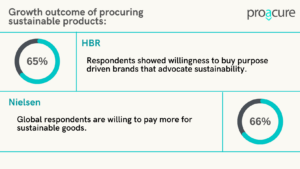Green Procurement
Ethan Chang, Proacure Research Team | July 11, 2022

Green procurement or sustainable procurement calls for avoidance of waste and appropriate usage of resources. With customers growing more aware of the importance of sustainability, businesses who can successfully implement it will always have a competitive advantage.
Supply chains are going global, with business activities often spanning and affecting multiple continents. Procurement is chasing a new goal-sustainability, different from the existing one of simply increasing efficiency and cutting cost while ensuring quality.
Green procurement is the process of procuring and sourcing goods and services in a mutually beneficial way for the organization and the environment, society, and economy: the organization gets value for money with positive outcomes for the environment, society, and economy. Apart from its own needs, an organization needs to consider the legal, human rights, ethics, safety, diversity, and inclusion angles; this is called the triple bottom line – people, planet and profit.
Value-Based Benefits
For companies, there are several incentives to pursue green procurement. For example, green procurement will help in ensuring continuity of supply chains by preventing draining and undue stress on resources. By practicing frugality in consumption of resources, organizations will save cost and at the same time reduce waste. By reducing carbon emissions, companies will save on taxes designed by governments to help curb increasing carbon emissions. Logistical planning can help reduce damage from commodity price swings and also track health and employment practices. An APQC study showed that organizations with green procurement policies have more efficient order processing and higher numbers of purchase order line items processed. Thus, by proactively adopting sustainable practices, companies can reduce risk and get a potential cost benefit.
Consumers are increasingly wanting to buy sustainable products. A recent report by Harvard Business Review revealed that certain categories of products with sustainability claims showed twice the growth of their traditional counterparts. It also says that in a recent survey, 65% respondents showed willingness to buy purpose-driven brands that advocate sustainability. Another consumer survey by Nielsen from 2015 shows that 66% of global respondents are willing to pay more for sustainable goods, up from 50% in 2013.

Eco-innovation and eco-entrepreneurship can also create new markets. A UNEP report suggests that eco-innovative companies of all sizes are growing, on average, at a rate of 15% annually, while their respective markets have remained stagnant.
Scope for bridging the gap and gaining a competitive advantage through green procurement practices,
- 71% of SMBs have no greenhouse gas (GHG) or energy policy
- 65% of SMBs have no anti-corruption policy
- 57% of SMBs have taken no data security measures
- 74% of SMBs have no policy to handle anti-discrimination actions
- Data collected as part of APQC’s Open Standards Benchmarking in procurement indicates that, of the organizations surveyed, 65% have initiated green procurement policies. Nearly 17% of responding organizations indicate that they plan to initiate green procurement policies in the next 2 years, and 18% indicate that they have no plans to initiate green procurement policies at all.
Necessary Steps
Businesses should begin by curbing unrealistic expectations from suppliers as it increases competition in an unhealthy way. They should instead enforce compliance to sustainable standards and practices from all suppliers, establish long-term sustainability goals, and establish and monitor social and environmental targets for their first-tier suppliers regarding second-tier suppliers. Lastly, they should collaborate with competitors and major suppliers to develop and disseminate industry wide sustainability standards.
Technology for Green Procurement
There are many uses of AI technologies that can help companies in their green procurement initiative. These include optimized energy system forecasting, “hyperlocal” weather forecasting for crop management, and supply chain monitoring and transparency software. By using digital technology such as IOT, companies can find the demand and usage data. Analytics and big data can allow companies to target products that have higher efficiency rates or those that use minimal or recycled packaging. IoT can provide real-time telemetry data by the real-time monitoring of the supply chain to reveal the details of production processes. Detailed planning for timely delivery of the product can be done by analyzing the real-time traffic data provided by the GPS that reduces production of carbon emission and the cost of fuel consumption.
Big Data
Big data is sets of gigantic or complex data that requires special tools to store, handle, and analyze. Companies have access to massive amounts of structured, unstructured, or semi-structured data that is being generated every day from GPS, point-of-sale (POS), Twitter feeds, Instagram, Facebook, call centers, and customer blogs. By employing Big Data, companies can better understand their customers’ expectations, provide suitable service to satisfy their needs, improve sales and income, expose risks in supply chains, and penetrate into new markets.
These techniques can help supply chain managers to predict external future events and adopt a proactive approach against them. This helps arm against supply chain risks such as natural hazards or fabricated, contextual and operational disruptions. One application in the retail supply chain can accurately predict a consumer’s tastes and preferences. BDA can be used to analyze data from news, social media, weather reporting and events as well as direct data inputs from multiple static and dynamic data points to provide the capability to predict and proactively plan all supply chain activities.
Suppliers
Conscious supply chain management can play a key role in driving sustainability. In recent years, a growing number of MNCs have opted to work with suppliers that adhere to environment and social sustainability standards. However, most of these suppliers are top-tier, and a lot of questionable practices come from lower-tier suppliers. As working with lower-tier suppliers that fail to adhere to standards can expose companies to environmental, social, and financial risks, it is important for them to adopt supply chain and supplier management technology and policies that can ensure sustainable practices from all stakeholders.
By gaining a deep understanding of your supply chain, companies can gather information on the practices of your suppliers and sub-suppliers for corporate social responsibility and sustainability to ensure more ethical supply chains. Multi-tier transparency ensures a company’s claims are delivered at all tiers, detailed data on important issues such as labor wages is collected, communication is made easy at all levels, and quick reaction in the event of a crisis is made possible. Multi-level transparency ensures businesses are properly equipped to deal with risks. Adoption of e-sourcing and e-procurement systems with cutting edge technologies discussed earlier can provide the transparency, tools, and control necessary to implement and enforce sustainable standards and practices.
Meeting Sustainability Standards?
Greenhouse gas emissions, energy-generation mix, water use, water pollution, and waste generation are some key metrics that identify sustainable business practices. An integrated software can help track the indicators necessary for sustainable efforts that a company chooses to focus on: such a software often allows adding weight (importance) to the indicators of importance to a company based on the need of the hour. Using digital solutions, businesses can leverage data for multiple purposes, including corporate sustainability, regulatory compliance, predictive analytics, and operational excellence.
Corporate Sustainability: Brief Case Studies
Philips is using digital technology to reduce waste after analyzing the product life cycle. The secondary market for components provided insights to reuse certain parts and thus extend the life of some existing equipment, such as X-ray machines.
In another example, mining companies use digitization to source and track the raw materials that are used in consumer products — such as tracing and verifying the sources of metals used in mobile phones. Agder Energi, a Norwegian hydropower company, is using AI and cloud technology to predict changing energy needs in Norway.
The organizations have started to realize the potential for green procurement to achieve cost savings and brand recognition. It is a great opportunity to achieve organizational goals and objectives.
Proacure is a procurement technology & data-science organization based in the San Francisco Bay Area. Our ‘Koreografy’ model leverages multiple frameworks like congruence of different data sets, fusion of digital, analytics and business processes, and synchronous collaboration between various stakeholders. The model enables 100% Spend Visibility with prescriptive actionable insights to transform Strategic Sourcing and help realize untapped value in the Supplier and Tail Spend. Proacure’s deliverables include cost savings of 7-30%, a 20%+ increase in EBITDA, cash flow optimization, and reduced supply-chain disruption.
Related Articles




